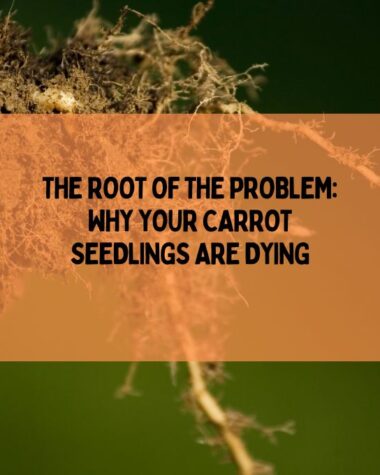If you’re considering growing carrots in raised beds is an excellent option. Raised beds offer several advantages over traditional gardening methods, including improved soil quality, drainage, and maintenance.
The practice of raised bed gardening dates back to ancient civilizations such as the Aztecs and Romans. Elevated garden beds gained popularity in Europe during the 18th century and have since spread worldwide. Today, raised bed gardening is famous for growing vegetables, herbs, and flowers.
In this article, we’ll cover everything you need to know about growing carrots in raised beds, including tips, techniques, and recommended varieties to try. Whether you’re a seasoned gardener or just starting, this guide will help you grow healthy and delicious carrots in your raised bed garden.
Getting Started: Setting Up Your Raised Bed

Before you can start growing carrots in your raised bed, you need to set it up properly. Here’s what you need to do:
- Choose the right location for your raised bed: Carrots need at least 6 hours of direct sunlight daily, so choose a location with plenty of sun. It’s also essential to ensure the spot is level and well-draining to prevent water from pooling around the roots.
- Build or buy a raised bed: Raised beds can be made from various materials, including wood, metal, and plastic. If you’re handy, you can build your raised bed using untreated lumber, but choose a type that will only rot slowly. Alternatively, you can buy a raised bed kit from a gardening store.
- Prepare the soil for planting: The soil in raised beds needs to be loose, well-draining, and rich in organic matter. Remove any grass, weeds, or debris from the bed and loosen the soil with a garden fork or tiller. Mix in some sand to improve drainage if your soil is heavy clay.
- Recommended soil mix for growing carrots: To create an ideal growing environment, mix equal parts of compost, vermiculite, and peat moss. This will create light, fluffy soil that drains well and retains moisture.
Related Read
- Why Do Carrots Sometimes Look Weird? Understanding Deformed Carrots And How To Fix Them
- Carrot Black Root Rot: Understanding And Preventing The Disease
- Carrots For Butterflies: How To Attract Black Swallowtails To Your Garden?
Planting Carrots in Raised Beds: Tips & Techniques

Once your raised bed is set up and ready, it’s time to plant your carrots. Here are some tips and techniques to help you grow healthy and tasty carrots:
- Selecting the right carrot seeds: Choose a variety of carrots suitable for your growing region and soil type. There are wide varieties of carrots, such as Nantes, Chantenay, and Danvers. Look for seeds that are fresh and of high quality.
- Planting depth and spacing: Carrot seeds should be planted about 1/4 to 1/2 inch deep and spaced about 1 to 2 inches apart. Once the seedlings emerge, thin them out to a spacing of 3 to 4 inches between plants. This will allow each carrot to have enough room to grow.
- Watering and fertilizing techniques: Carrots need regular watering to keep the soil moist but not waterlogged. Water deeply once or twice a week, you depend on weather conditions. Avoid overhead watering to prevent disease. Fertilize your carrots with a balanced fertilizer once a month.
- Companion planting for carrots: Carrots grow well with certain companion plants, such as onions, leeks, and garlic, which help to repel pests. Avoid planting carrots near cabbage family members or fennel, which can attract pests.
- Tips for preventing pests and diseases: Keep your raised bed clean and free of debris to prevent pests and diseases. Cover your carrots with row covers to prevent insect infestations. Monitor your plants regularly for signs of damage or disease and treat them as necessary with organic methods such as insecticidal soap or neem oil.
Following these tips and techniques, you can grow healthy and delicious carrots in your raised bed garden.
Maintaining Your Carrot Plants

Growing healthy and tasty carrots requires some maintenance throughout the growing season. Here are some tips for maintaining your carrot plants:
- Thinning and weeding your carrot plants: As your carrot plants grow, thin them out to ensure that each carrot has enough room to develop properly. Remove any weeds around your carrot plants, as they can compete for water and nutrients.
- Monitoring the health of your plants: Regularly monitor your carrot plants for signs of pests, diseases, or nutrient deficiencies. Look for any yellowing leaves, wilting, or spots on the leaves. If you notice any problems, take action to address them as soon as possible.
- Protecting your plants from extreme weather conditions: Carrots can be sensitive to extreme weather conditions, such as heat waves or heavy rain. Protect your plants from these conditions by providing shade or covering them with row covers. Water your plants during dry spells to prevent the soil from drying out.
- Harvesting your carrots at the right time: The ideal time to harvest them is when they are fully mature before they become too large and woody. Depending on the variety, this usually occurs about 60 to 80 days after planting. To harvest your carrots, gently pull them out of the soil by the green tops, careful not to damage the roots.
Following these maintenance tips ensures that your carrot plants stay healthy and productive throughout the growing season.
Also, Read
- Growing Nantes Carrots: Tips And Techniques For A Bountiful Harvest
- How To Grow Delicious Danvers Carrots?
- How To Grow Imperator Carrots?
Varieties of Carrots to Grow in Raised Beds
Carrots come in many different shapes, sizes, and colors, making them a versatile and tasty addition to any raised bed garden. Here are four popular carrot varieties that are well-suited for raised beds:
- ‘Nantes‘: This classic variety has a sweet, crisp, and tender texture. It is cylindrical and typically grows to about 6 inches long. ‘Nantes’ carrots are ideal for raised beds because they are easy to grow and do well in various soil types.
- ‘Chantenay‘: This variety is short and stubby, with a broad shoulder and tapered end. ‘Chantenay’ carrots have a sweet, crunchy texture and are ideal for growing in raised beds with heavy soil or clay. They also store well for extended periods.
- ‘Danvers‘: This variety has a conical shape, with broad shoulders and a tapered end. ‘Danvers’ carrots have a sweet and tender texture and are ideal for growing in raised beds with loamy soil. They are also resistant to cracking and splitting.
- ‘Purple Haze’: This unique variety has deep purple skin and orange flesh, making it a visually striking addition to any raised bed garden. ‘Purple Haze’ carrots have a sweet, slightly spicy flavor and are rich in antioxidants. They grow best in raised beds with loose, well-draining soil.
Tips on Selecting the Best Variety for Your Garden: Guide to Growing
When selecting a carrot variety for your raised bed garden, consider your soil type, climate, and personal taste preferences. Some varieties may perform better in certain soil conditions or be more resistant to pests and diseases.
Additionally, consider the size and shape of the carrots, as well as their flavor and texture, to determine which variety is best suited for your culinary needs. You can ensure a bountiful harvest of delicious and healthy carrots by selecting a suitable variety for your garden.
Conclusion
Growing carrots in raised beds can be a rewarding and enjoyable experience for gardeners of all skill levels. You can ensure a successful and productive harvest by selecting the right location, preparing the soil properly, choosing suitable carrot varieties, and following proper planting and maintenance techniques.
Whether you want to add some color to your raised bed garden with purple carrots or grow classic varieties like ‘Nantes’ and ‘Chantenay,’ there is a carrot variety that will suit your needs. With patience, care, and attention to detail, you can grow healthy, tasty, nutritious carrots that delight your taste buds and impress your friends and family.







